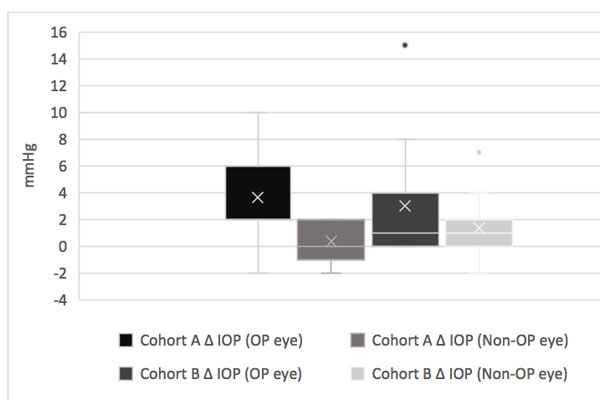Using tropicamide and phenylephrine without cyclopentolate for pupil dilation in cataract surgery reduces postoperative intraocular pressure rise
Abstract
The aim of this retrospective study was to evaluate whether intraocular (IOP) elevation post-cataract surgery can be reduced by using tropicamide and phenylephrine only, without cyclopentolate. Medical records across two surgical facilities were analyzed. One surgical facility (Cohort A) used a combination of tropicamide, cyclopentolate, and phenylephrine preoperatively, while the other (Cohort B) used tropicamide and phenylephrine only. Of patients in Cohort A, 63.6% (n = 7) had a higher IOP in the operated eye, while it was only 27.3% (n = 3) in Cohort B. Therefore, it is preferable to exclude the use of cyclopentolate in the preoperative dilation regimen of patients undergoing cataract surgery. However, a study with a larger sample population is required to further evaluate the significance of these results.
References
Zanetti F, Fulco EA, Chaves FR, da Costa Pinto A, Arieta CE, Lira RP. Effect of preoperative use of topical prednisolone acetate, ketorolac tromethamine, nepafenac and placebo, on the maintenance of intraoperative mydriasis during cataract surgery: A randomized trial. Indian J Ophthalmol. 2012;60(4):277-281.
Hancox J, Murdoch I, Parmar D. Changes in intraocular pressure following diagnostic mydriasis with cyclopentolate 1%. Eye (London, England). 2002;16(5):562-566.
Li G, Farsiu S, Chiu SJ, et al. Pilocarpine-induced dilation of Schlemm’s canal and prevention of lumen collapse at elevated intraocular pressures in living mice visualized by OCT. Invest Ophthalmol Vis Sci. 2014;55(6):3737-3746.
Lahdes K, Huupponen R, Kaila T, Monti D, Saettone MF, Salminen L. Plasma concentrations and ocular effects of cyclopentolate after ocular application of three formulations. Br J Clin Pharmacol. 1993;35(5):479-483.
Sani RY, Hassan S, Habib SG, Ifeanyichukwu EP. Cycloplegic effect of atropine compared with cyclopentolate-tropicamide combination in children with hypermetropia. Niger Med J. 2016;57(3):173-177.
Stanley RG. Ocular clinical pharmacology. In: Maddison JE, Page SW, Church DB, editors. Small Animal Clinical Pharmacology (2nd Edition). Edinburgh: WB Saunders; 2008. p. 557-573.
Kilic O, Ozturk M, Ata Gozcelioglu E. Tropicamide ophthalmic solution reduces clozapine-induced sialorrhea: a case report. Psychiat Clin Psych. 2017;27(4):431-434.

Copyright (c) 2020 Rachel Xuan, Keith Ong

This work is licensed under a Creative Commons Attribution 4.0 International License.
Authors who publish with this journal agree to the following terms:
- Authors retain copyright and grant the journal right of first publication, with the work twelve (12) months after publication simultaneously licensed under a Creative Commons Attribution License that allows others to share the work with an acknowledgement of the work's authorship and initial publication in this journal.
- Authors are able to enter into separate, additional contractual arrangements for the non-exclusive distribution of the journal's published version of the work (e.g., post it to an institutional repository or publish it in a book), with an acknowledgement of its initial publication in this journal.
- Authors are permitted and encouraged to post their work online (e.g., in institutional repositories or on their website) prior to and during the submission process, as it can lead to productive exchanges, as well as earlier and greater citation of published work (See The Effect of Open Access).


